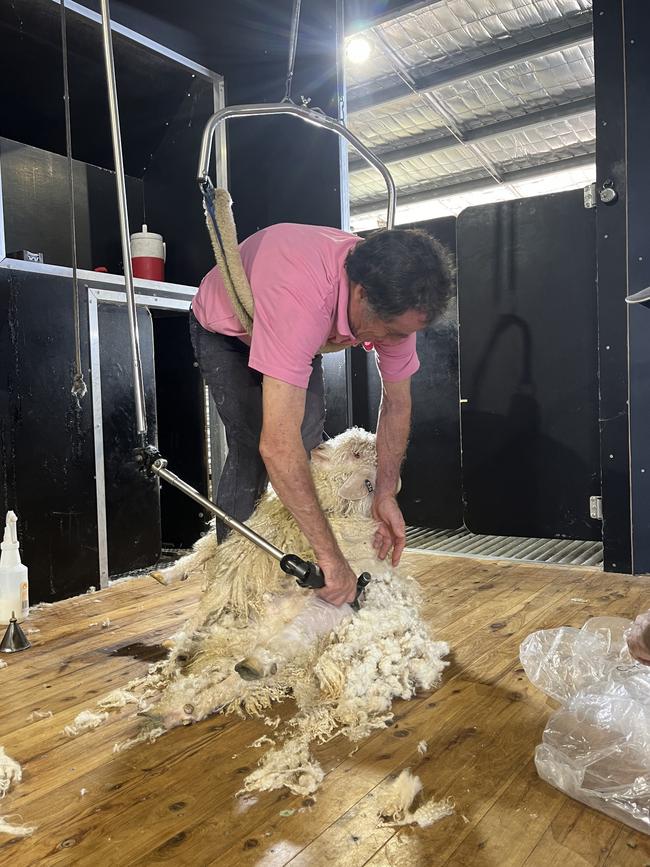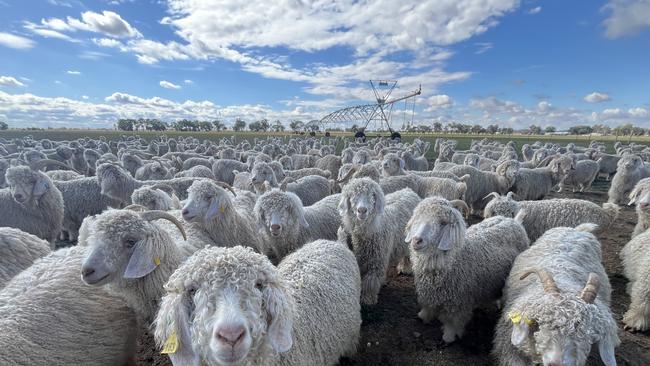Mohair could be an option for those turning away from wool
Wool growers can only dream of earning $80/kg greasy for their fibre, but mohair producers GT and Werner Ferreira, are doing exactly that, and say it’s not hard to swap from sheep to goats.
A quest to produce world leading fibre has lead one family across the globe to run Angora goats and ultrafine Merinos in southern NSW.
Elite fibre producers GT and Werner Ferreira leave nothing to chance when it comes to producing mohair and ultrafine wool, even if it means moving continents.
And that includes running the goats and sheep under pivot irrigation to ensure even nutrition, healthy animals and consistent fibre that meets the highest standards.
They are also keen to radically shift the reputation of Angora goats, from hobby farm realm to commercial status, either alongside another farming enterprise or as a stand alone operation.
Brothers, GT and Werner were running an Angora goat and cropping enterprise across 12,500ha in South Africa, but first began looking at transferring their operation to Australia in about 2005.
After a series of years leasing country and agisting their Angora goats across NSW, they eventually were able to buy two farms in their preferred location between Corowa and Howlong in southern NSW, totalling about 200ha, about four years ago.
It ticked the boxes in terms of climate and it could provide feed year round thanks to irrigation.

It was the next stage in a process that saw 250 embryos exported from their own flock in South Africa, harvested from the very best of their Angora goats there, to act as the nucleus of their mohair operation in Australia.
VOLUME WORKS
The sheer number of goats running in paddocks, and some running alongside their ultrafine Merinos, have raised eyebrows in the district, but GT said the figures well and truly stacked up.
“We like to show how the returns from Angora goats compare to other livestock enterprises,” GT said.
“At the moment, our flock is young overall, with about two-thirds young animals and one-third older animals, which affects the average cut per head across the flock.
“An ultrafine Angora goat is the equivalent of 0.8 dry sheep equivalents, is shorn twice a year, and produces a total of 3.5kg of mohair, with an income of $138.
“As the flock gets older, the kilograms cut increases but the value decreases.”
So for one DSE unit (rounding 0.8 up to 1) each Angora goat produces income of $172.50.
Using DSEs was one way to compare returns, GT said, with a lactating cow rated at 15 DSE, would need to earn $2588 to create the same income as one goat.
“Feed efficiency means more goats can be run per hectare,” he said.
“Angora goats produce fibre more efficiently than any other livestock, meaning they produce large quantities of fibre per unit of body weight, plus or minus 250mm staple length per annum.”
FARM TO FASHION
The Ferreira brothers already had strong relationships within the fashion industry, shipping fibre direct to top making plants in Europe to be used in some of the best known brands.
Some of their mohair has gone into limited edition suits and super knit wear ranges.
These relationships, built on trust and reliability of supply, reward the Ferreiras for their efforts financially, earning up to $80/kg greasy for the better kid lines and averaging $42/kg greasy including fleece, locks and stains across the whole clip.
And it’s this strong link with those retailers and their consumers which feeds back into management decisions made with their goats and sheep.
“These buyers, they want the best quality mohair, or a mohair/wool blend, and they want to know there is a consistent supply, year-in-year-out,” GT said.
“It’s why we decided to buy a property that could be irrigated – if we say that we cannot supply one year because of a drought, they will just lose faith in you as a supplier and it’s as simple as that.
“Irrigation is to make us more resilient in terms of supply.”
Buying a smaller, more productive block, also meant lower overheads and less labour than a more extensive property similar to the one they used to run in South Africa.
When the Ferreiras bought their country, it had been used for cropping, and their radical revamp has seen the installation of two pivot and sprinkler systems and more on the way with the aim to get 95 per cent of the farm irrigated.

The country was laser levelled with a fall of 70mm per 100m, to maximise water and land efficiency and minimise water logging and allow maximum pasture growth.
Initially crops were planted and undersown with lucerne, but the goal was always to move towards a permanent multi species pasture which offered both winter and summer grazing.
Those pastures still include lucerne, but also winter and summer dominant species of cocksfoot and fescues, plantain, clovers, chicory and prairie grass.
That goats like weeds is well known, and this is an added benefit to producing fibre with very low if any levels of vegetable matter.
This in turn means spraying is not required anymore, further cutting down the costs of production.
High quality feed, with good nutritional value, alongside good water, are two of the key pillars for elite mohair production, GT said.
And while the pasture offers consistent quality and volume, the goats’ diet is boosted with protein, fed as lupins, at key times like the final trimester of pregnancy, to aid with follicle development, at between 60-103 days of foetus development.
Does are also fed lupins during mating season to stimulate ovulation, and body weight is managed to increase weight just before mating to boost conception rates.
FINE TUNING
The properties also needed to be re-fenced. Hinge joint was not suitable for goats, with young kids able to move through fences and older goats becoming caught sometimes They opted for netting, which makes sure the goats stay in their right paddock.
The fine tuning does not stop in the management of the animal welfare and feeding of the goats either.

At shearing, each fleece is carefully skirted to remove any stain (though this is limited by crutching every three months) and classed into its type.
But when it comes to the high value kid shearing, the fleece is tracked through its electronic identification tag back to the animal, with the information used to help with classing decisions.
Each fleece is then individually tested using laser scanning to be able to provide parcels of fibre to processors with specific characteristics.
And when you are selling your fibre into limited edition suits, which some buyers of the mohair were, GT said it was critical to be able to clearly differentiate and stand by the parcel of fibre that was being offered.
The fibre is sold direct to the users, and while the brothers are not keen to divulge exactly the cost of doing so, they said it may surprise some how cost effective it was.
“We will say that it is less than 2.5 per cent of the fibre value,” GT said.
The individual testing of each fleece and then recording this against individual goats has also assisted in the classing process.
Extensive records are kept on every goat, and with a clear record of performance and selection of elite performers, the brothers said they are continually increasing the quality of their own flock.
They also are conscious of other aspects that generate profitability, like mothering ability and fertility. Kidding rates are at about 140 per cent, and does (females) which twin are put into pens for a short time (24-48 hours) to ensure they mother up properly before being released.
It’s a practise that means losses are very low, losing less than 1 per cent of all kids just down to management.
But overarching every selection decision is a top down approach. Those who buy the fibre are clear in their specifications for micron and colour, and the Ferreiras breed goats that can deliver this.
It was a request for a wool/mohair mix that encouraged them then to run ultra fine wool sheep, and running with goats ensures low vegetable matter in the wool clip too.
The Merinos are ultrafine, testing at about 12-14.5 micron with a comfort factor of 100 per cent and an average length of 90-95mm, and the wool blended with mohair. They are not mulesed with an average adult body weight of 60-65kg.
The only time the Ferreiras are super conscious of running goats and sheep is at shearing. The shed is cleaned intensively between goat and sheep shearing to ensure there is no cross over of mohair and wool.

There’s more than 2000 goats and more than 1200 sheep running on the Corowa farms, but the brothers are not keen to brag about the title as the biggest pure Angora mohair producers in Australia.
What they are keen to promote is that goats are a commercial option, and say the numbers stack up.
“For us, wool and mohair are complimentary fibres - they bring brilliance out of nature,” he said
“We hope people might see some possibilities in running Angora goats if they want to try a different enterprise, especially anyone who runs sheep and has the infrastructure.
“They may see a chance to make some income and we’re happy to talk to people about it.”




